Health and Safety: Risk Management in UK Oil and Gas Sector
VerifiedAdded on 2023/06/10
|16
|3919
|217
Report
AI Summary
This report provides an in-depth analysis of health and safety practices within the UK oil and gas sector. It begins with an executive summary highlighting the critical aspects of risk management, employee training, and the role of health and safety practitioners. The report explores the responsibilities of health and safety officers, details offshore accidents and risks, and examines the ethical and business cases for robust safety management. It also covers key regulations like RIDDOR and the Health and Safety at Work Act, along with the importance of employee training and the use of advanced technologies like VOC detectors and subsea sensors. The report presents statistical data on hazards, discusses fire and evacuation procedures, and addresses business and ethical issues related to the industry. It emphasizes the need for continuous improvement in health and safety standards to protect workers and the environment.
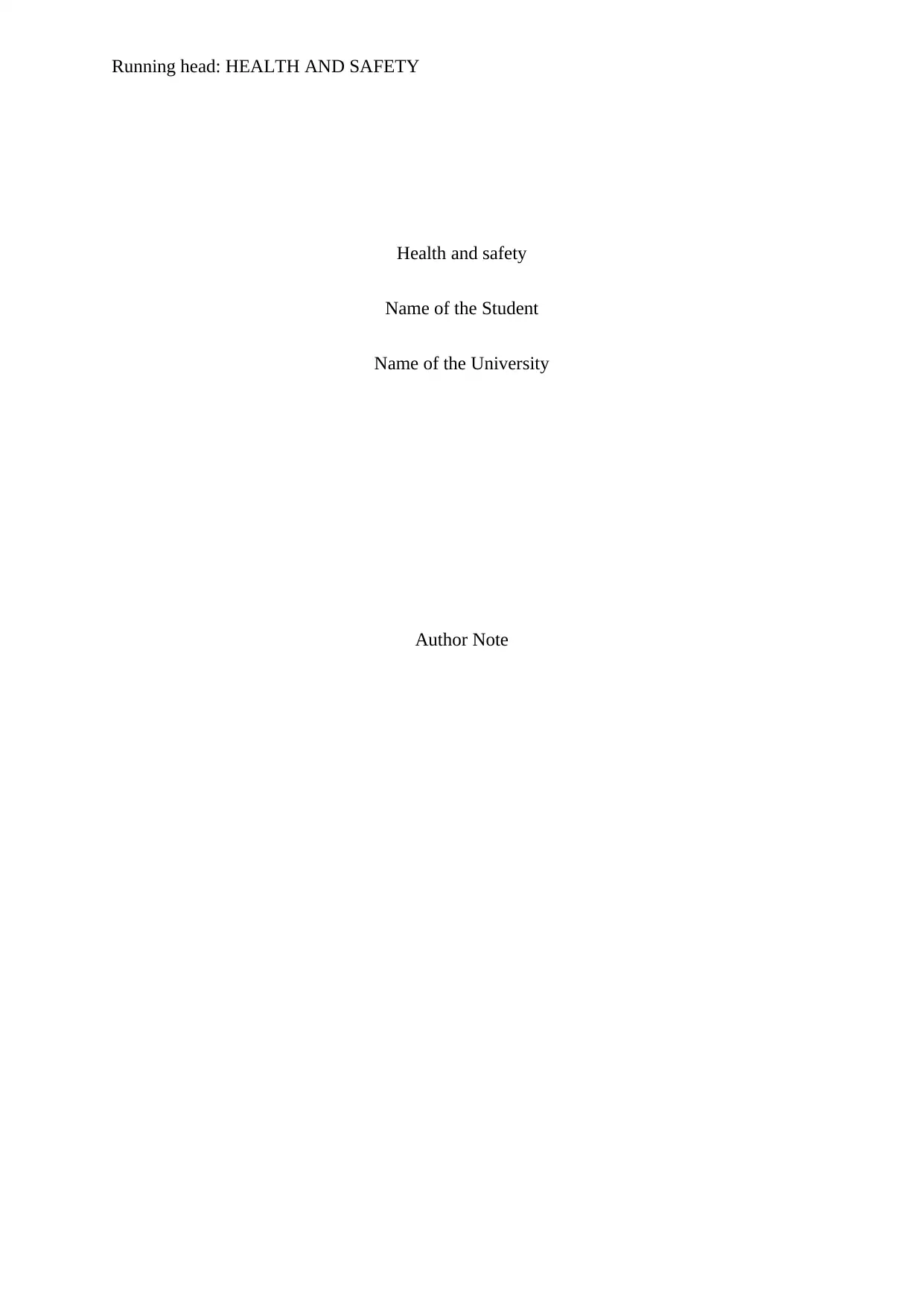
Running head: HEALTH AND SAFETY
Health and safety
Name of the Student
Name of the University
Author Note
Health and safety
Name of the Student
Name of the University
Author Note
Paraphrase This Document
Need a fresh take? Get an instant paraphrase of this document with our AI Paraphraser
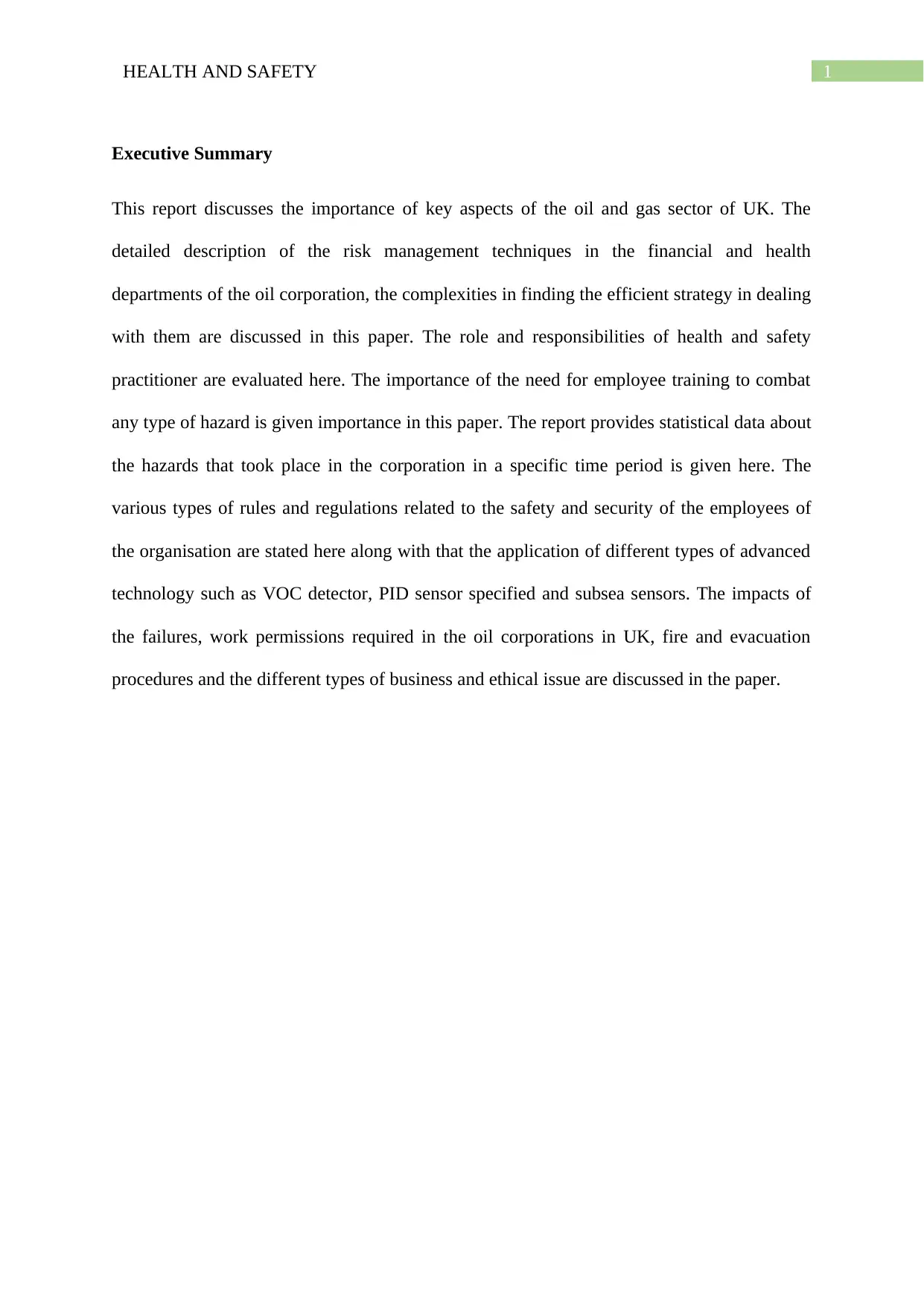
1HEALTH AND SAFETY
Executive Summary
This report discusses the importance of key aspects of the oil and gas sector of UK. The
detailed description of the risk management techniques in the financial and health
departments of the oil corporation, the complexities in finding the efficient strategy in dealing
with them are discussed in this paper. The role and responsibilities of health and safety
practitioner are evaluated here. The importance of the need for employee training to combat
any type of hazard is given importance in this paper. The report provides statistical data about
the hazards that took place in the corporation in a specific time period is given here. The
various types of rules and regulations related to the safety and security of the employees of
the organisation are stated here along with that the application of different types of advanced
technology such as VOC detector, PID sensor specified and subsea sensors. The impacts of
the failures, work permissions required in the oil corporations in UK, fire and evacuation
procedures and the different types of business and ethical issue are discussed in the paper.
Executive Summary
This report discusses the importance of key aspects of the oil and gas sector of UK. The
detailed description of the risk management techniques in the financial and health
departments of the oil corporation, the complexities in finding the efficient strategy in dealing
with them are discussed in this paper. The role and responsibilities of health and safety
practitioner are evaluated here. The importance of the need for employee training to combat
any type of hazard is given importance in this paper. The report provides statistical data about
the hazards that took place in the corporation in a specific time period is given here. The
various types of rules and regulations related to the safety and security of the employees of
the organisation are stated here along with that the application of different types of advanced
technology such as VOC detector, PID sensor specified and subsea sensors. The impacts of
the failures, work permissions required in the oil corporations in UK, fire and evacuation
procedures and the different types of business and ethical issue are discussed in the paper.
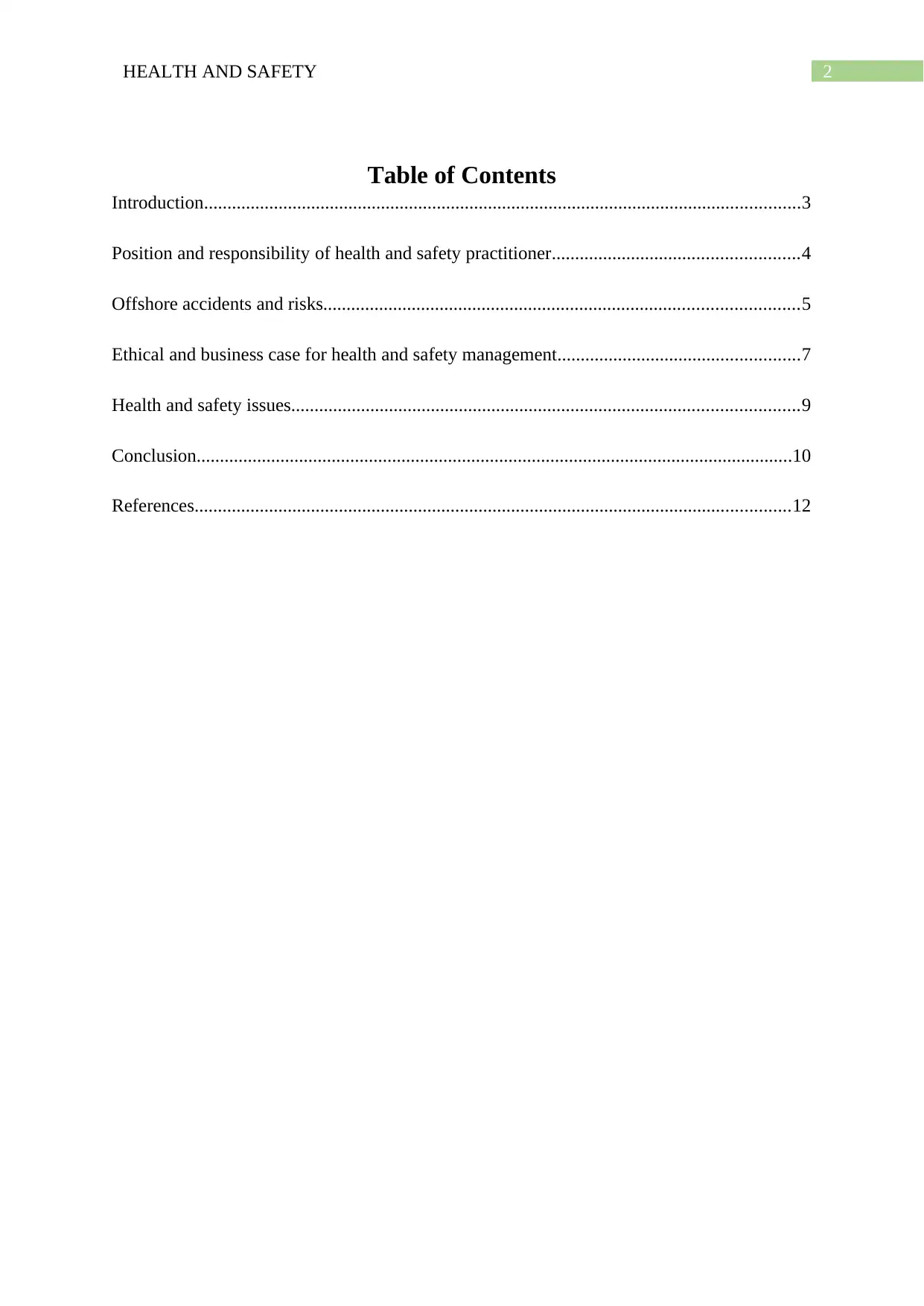
2HEALTH AND SAFETY
Table of Contents
Introduction................................................................................................................................3
Position and responsibility of health and safety practitioner.....................................................4
Offshore accidents and risks......................................................................................................5
Ethical and business case for health and safety management....................................................7
Health and safety issues.............................................................................................................9
Conclusion................................................................................................................................10
References................................................................................................................................12
Table of Contents
Introduction................................................................................................................................3
Position and responsibility of health and safety practitioner.....................................................4
Offshore accidents and risks......................................................................................................5
Ethical and business case for health and safety management....................................................7
Health and safety issues.............................................................................................................9
Conclusion................................................................................................................................10
References................................................................................................................................12
⊘ This is a preview!⊘
Do you want full access?
Subscribe today to unlock all pages.

Trusted by 1+ million students worldwide
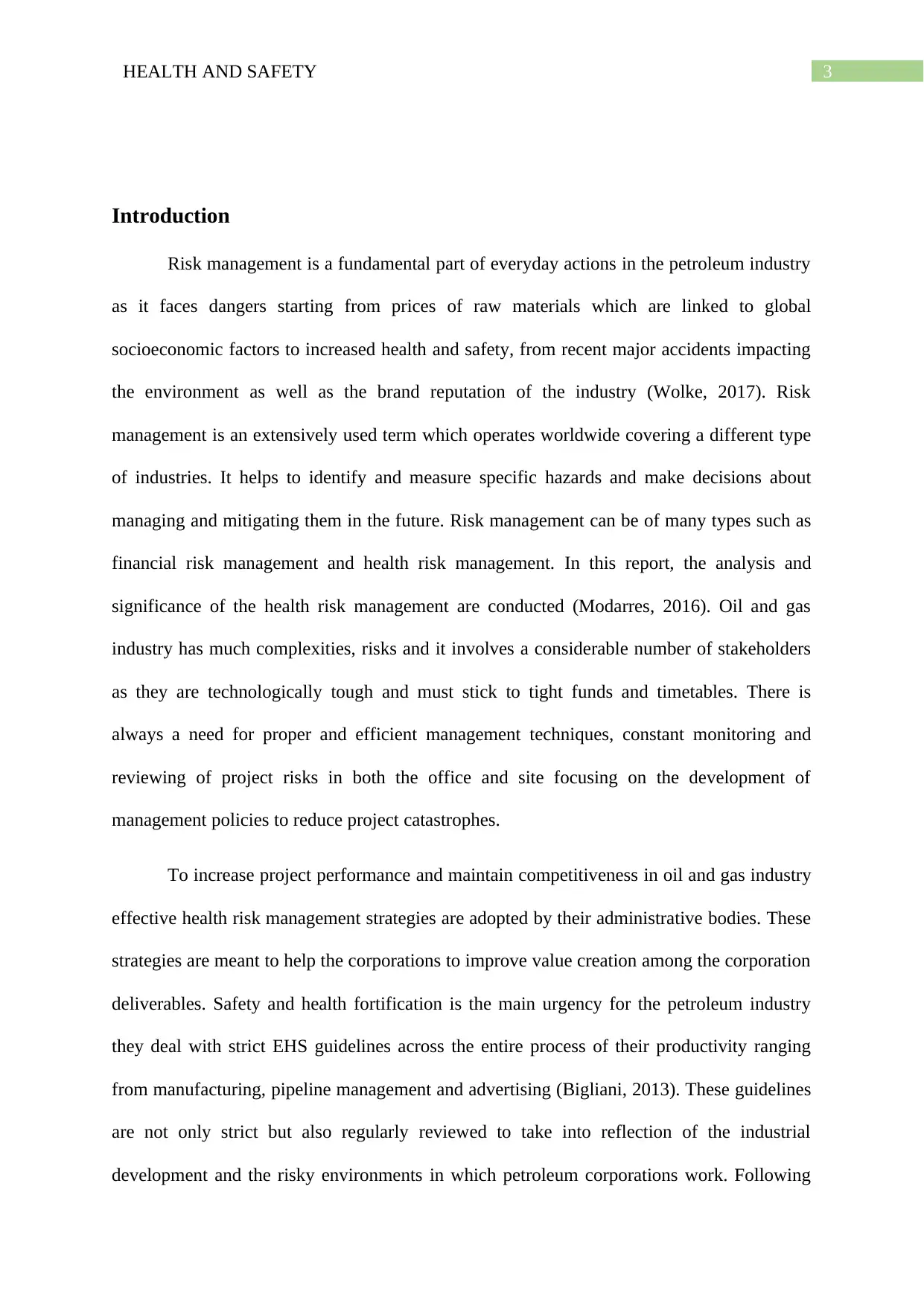
3HEALTH AND SAFETY
Introduction
Risk management is a fundamental part of everyday actions in the petroleum industry
as it faces dangers starting from prices of raw materials which are linked to global
socioeconomic factors to increased health and safety, from recent major accidents impacting
the environment as well as the brand reputation of the industry (Wolke, 2017). Risk
management is an extensively used term which operates worldwide covering a different type
of industries. It helps to identify and measure specific hazards and make decisions about
managing and mitigating them in the future. Risk management can be of many types such as
financial risk management and health risk management. In this report, the analysis and
significance of the health risk management are conducted (Modarres, 2016). Oil and gas
industry has much complexities, risks and it involves a considerable number of stakeholders
as they are technologically tough and must stick to tight funds and timetables. There is
always a need for proper and efficient management techniques, constant monitoring and
reviewing of project risks in both the office and site focusing on the development of
management policies to reduce project catastrophes.
To increase project performance and maintain competitiveness in oil and gas industry
effective health risk management strategies are adopted by their administrative bodies. These
strategies are meant to help the corporations to improve value creation among the corporation
deliverables. Safety and health fortification is the main urgency for the petroleum industry
they deal with strict EHS guidelines across the entire process of their productivity ranging
from manufacturing, pipeline management and advertising (Bigliani, 2013). These guidelines
are not only strict but also regularly reviewed to take into reflection of the industrial
development and the risky environments in which petroleum corporations work. Following
Introduction
Risk management is a fundamental part of everyday actions in the petroleum industry
as it faces dangers starting from prices of raw materials which are linked to global
socioeconomic factors to increased health and safety, from recent major accidents impacting
the environment as well as the brand reputation of the industry (Wolke, 2017). Risk
management is an extensively used term which operates worldwide covering a different type
of industries. It helps to identify and measure specific hazards and make decisions about
managing and mitigating them in the future. Risk management can be of many types such as
financial risk management and health risk management. In this report, the analysis and
significance of the health risk management are conducted (Modarres, 2016). Oil and gas
industry has much complexities, risks and it involves a considerable number of stakeholders
as they are technologically tough and must stick to tight funds and timetables. There is
always a need for proper and efficient management techniques, constant monitoring and
reviewing of project risks in both the office and site focusing on the development of
management policies to reduce project catastrophes.
To increase project performance and maintain competitiveness in oil and gas industry
effective health risk management strategies are adopted by their administrative bodies. These
strategies are meant to help the corporations to improve value creation among the corporation
deliverables. Safety and health fortification is the main urgency for the petroleum industry
they deal with strict EHS guidelines across the entire process of their productivity ranging
from manufacturing, pipeline management and advertising (Bigliani, 2013). These guidelines
are not only strict but also regularly reviewed to take into reflection of the industrial
development and the risky environments in which petroleum corporations work. Following
Paraphrase This Document
Need a fresh take? Get an instant paraphrase of this document with our AI Paraphraser
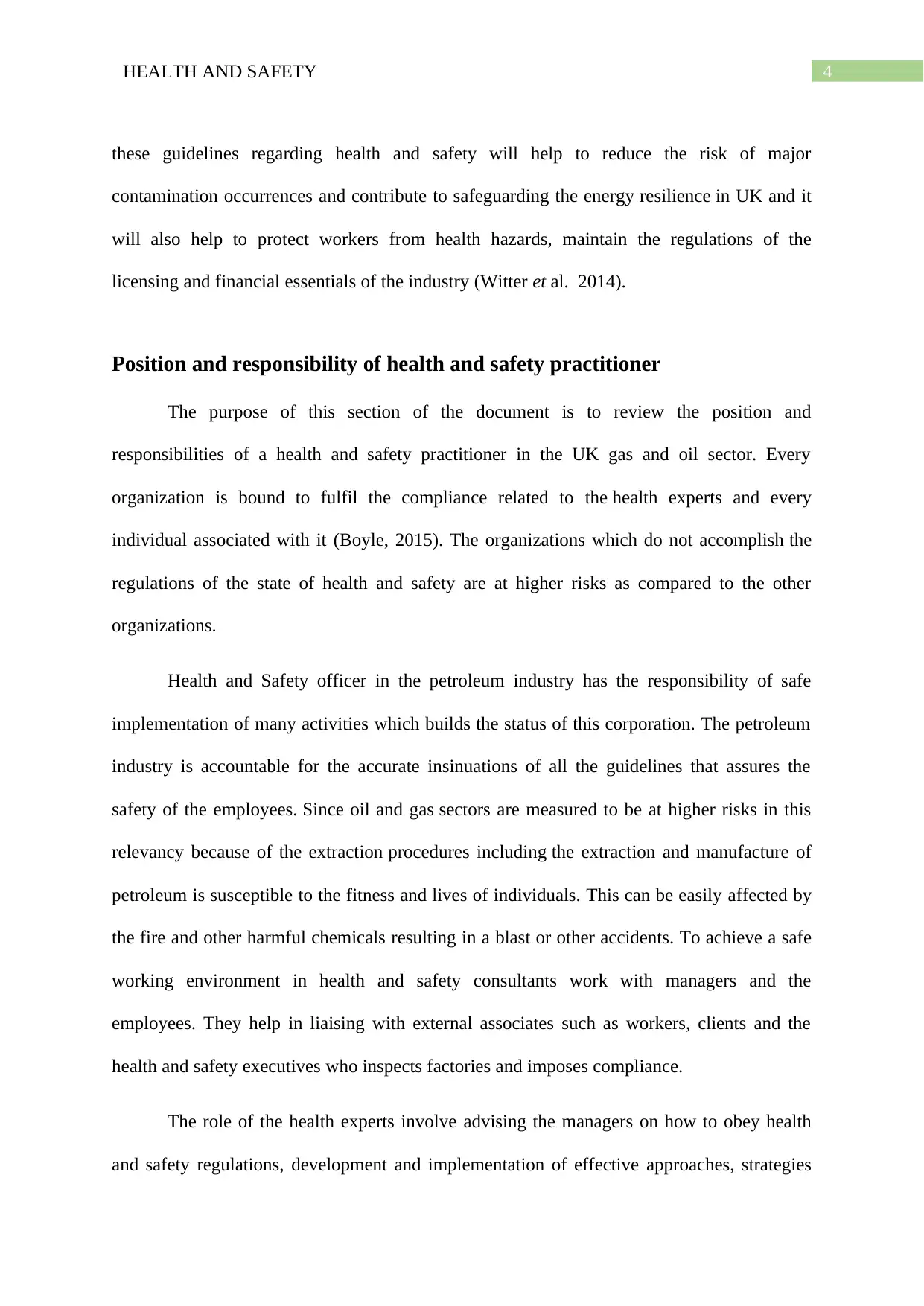
4HEALTH AND SAFETY
these guidelines regarding health and safety will help to reduce the risk of major
contamination occurrences and contribute to safeguarding the energy resilience in UK and it
will also help to protect workers from health hazards, maintain the regulations of the
licensing and financial essentials of the industry (Witter et al. 2014).
Position and responsibility of health and safety practitioner
The purpose of this section of the document is to review the position and
responsibilities of a health and safety practitioner in the UK gas and oil sector. Every
organization is bound to fulfil the compliance related to the health experts and every
individual associated with it (Boyle, 2015). The organizations which do not accomplish the
regulations of the state of health and safety are at higher risks as compared to the other
organizations.
Health and Safety officer in the petroleum industry has the responsibility of safe
implementation of many activities which builds the status of this corporation. The petroleum
industry is accountable for the accurate insinuations of all the guidelines that assures the
safety of the employees. Since oil and gas sectors are measured to be at higher risks in this
relevancy because of the extraction procedures including the extraction and manufacture of
petroleum is susceptible to the fitness and lives of individuals. This can be easily affected by
the fire and other harmful chemicals resulting in a blast or other accidents. To achieve a safe
working environment in health and safety consultants work with managers and the
employees. They help in liaising with external associates such as workers, clients and the
health and safety executives who inspects factories and imposes compliance.
The role of the health experts involve advising the managers on how to obey health
and safety regulations, development and implementation of effective approaches, strategies
these guidelines regarding health and safety will help to reduce the risk of major
contamination occurrences and contribute to safeguarding the energy resilience in UK and it
will also help to protect workers from health hazards, maintain the regulations of the
licensing and financial essentials of the industry (Witter et al. 2014).
Position and responsibility of health and safety practitioner
The purpose of this section of the document is to review the position and
responsibilities of a health and safety practitioner in the UK gas and oil sector. Every
organization is bound to fulfil the compliance related to the health experts and every
individual associated with it (Boyle, 2015). The organizations which do not accomplish the
regulations of the state of health and safety are at higher risks as compared to the other
organizations.
Health and Safety officer in the petroleum industry has the responsibility of safe
implementation of many activities which builds the status of this corporation. The petroleum
industry is accountable for the accurate insinuations of all the guidelines that assures the
safety of the employees. Since oil and gas sectors are measured to be at higher risks in this
relevancy because of the extraction procedures including the extraction and manufacture of
petroleum is susceptible to the fitness and lives of individuals. This can be easily affected by
the fire and other harmful chemicals resulting in a blast or other accidents. To achieve a safe
working environment in health and safety consultants work with managers and the
employees. They help in liaising with external associates such as workers, clients and the
health and safety executives who inspects factories and imposes compliance.
The role of the health experts involve advising the managers on how to obey health
and safety regulations, development and implementation of effective approaches, strategies
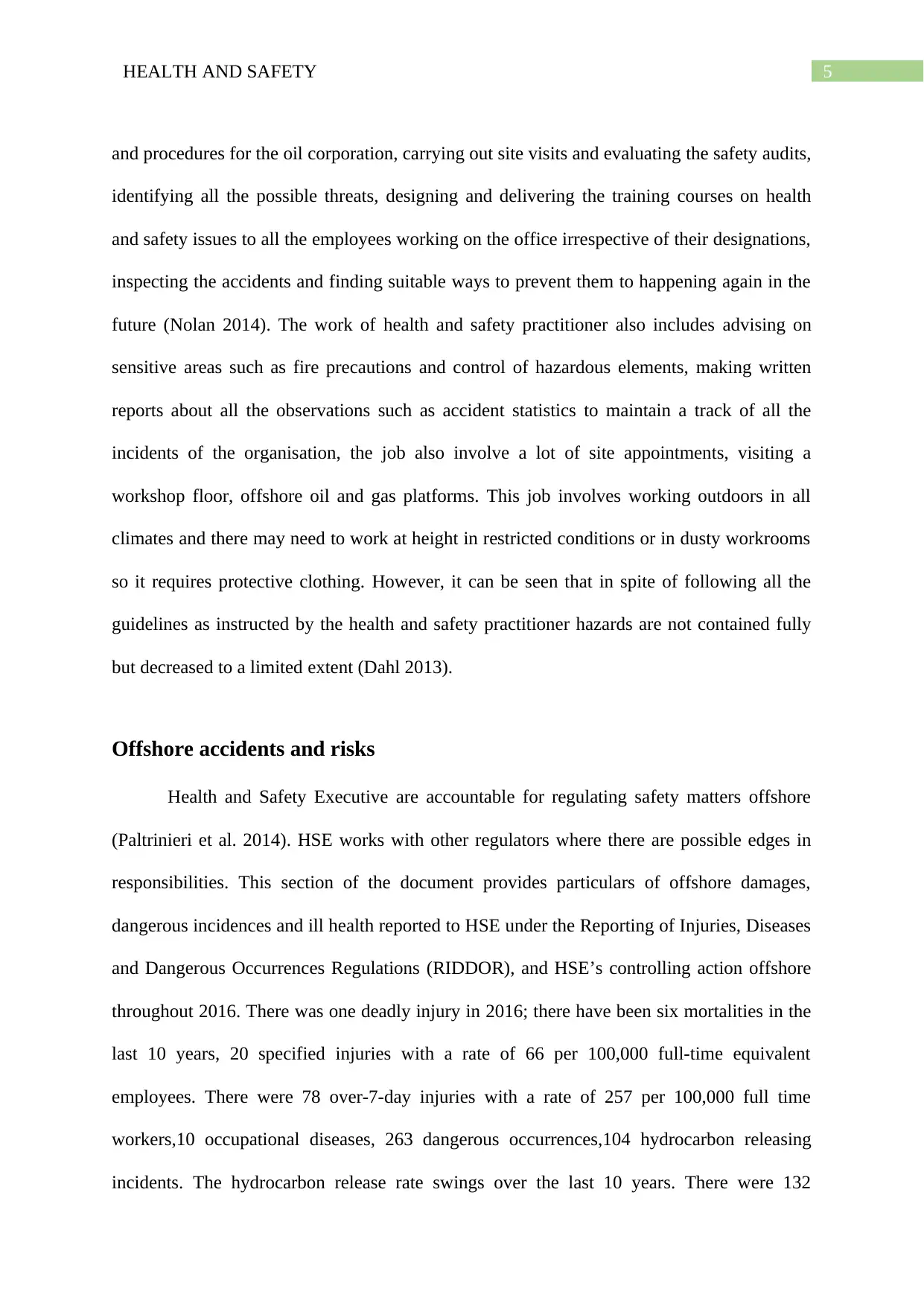
5HEALTH AND SAFETY
and procedures for the oil corporation, carrying out site visits and evaluating the safety audits,
identifying all the possible threats, designing and delivering the training courses on health
and safety issues to all the employees working on the office irrespective of their designations,
inspecting the accidents and finding suitable ways to prevent them to happening again in the
future (Nolan 2014). The work of health and safety practitioner also includes advising on
sensitive areas such as fire precautions and control of hazardous elements, making written
reports about all the observations such as accident statistics to maintain a track of all the
incidents of the organisation, the job also involve a lot of site appointments, visiting a
workshop floor, offshore oil and gas platforms. This job involves working outdoors in all
climates and there may need to work at height in restricted conditions or in dusty workrooms
so it requires protective clothing. However, it can be seen that in spite of following all the
guidelines as instructed by the health and safety practitioner hazards are not contained fully
but decreased to a limited extent (Dahl 2013).
Offshore accidents and risks
Health and Safety Executive are accountable for regulating safety matters offshore
(Paltrinieri et al. 2014). HSE works with other regulators where there are possible edges in
responsibilities. This section of the document provides particulars of offshore damages,
dangerous incidences and ill health reported to HSE under the Reporting of Injuries, Diseases
and Dangerous Occurrences Regulations (RIDDOR), and HSE’s controlling action offshore
throughout 2016. There was one deadly injury in 2016; there have been six mortalities in the
last 10 years, 20 specified injuries with a rate of 66 per 100,000 full-time equivalent
employees. There were 78 over-7-day injuries with a rate of 257 per 100,000 full time
workers,10 occupational diseases, 263 dangerous occurrences,104 hydrocarbon releasing
incidents. The hydrocarbon release rate swings over the last 10 years. There were 132
and procedures for the oil corporation, carrying out site visits and evaluating the safety audits,
identifying all the possible threats, designing and delivering the training courses on health
and safety issues to all the employees working on the office irrespective of their designations,
inspecting the accidents and finding suitable ways to prevent them to happening again in the
future (Nolan 2014). The work of health and safety practitioner also includes advising on
sensitive areas such as fire precautions and control of hazardous elements, making written
reports about all the observations such as accident statistics to maintain a track of all the
incidents of the organisation, the job also involve a lot of site appointments, visiting a
workshop floor, offshore oil and gas platforms. This job involves working outdoors in all
climates and there may need to work at height in restricted conditions or in dusty workrooms
so it requires protective clothing. However, it can be seen that in spite of following all the
guidelines as instructed by the health and safety practitioner hazards are not contained fully
but decreased to a limited extent (Dahl 2013).
Offshore accidents and risks
Health and Safety Executive are accountable for regulating safety matters offshore
(Paltrinieri et al. 2014). HSE works with other regulators where there are possible edges in
responsibilities. This section of the document provides particulars of offshore damages,
dangerous incidences and ill health reported to HSE under the Reporting of Injuries, Diseases
and Dangerous Occurrences Regulations (RIDDOR), and HSE’s controlling action offshore
throughout 2016. There was one deadly injury in 2016; there have been six mortalities in the
last 10 years, 20 specified injuries with a rate of 66 per 100,000 full-time equivalent
employees. There were 78 over-7-day injuries with a rate of 257 per 100,000 full time
workers,10 occupational diseases, 263 dangerous occurrences,104 hydrocarbon releasing
incidents. The hydrocarbon release rate swings over the last 10 years. There were 132
⊘ This is a preview!⊘
Do you want full access?
Subscribe today to unlock all pages.

Trusted by 1+ million students worldwide

6HEALTH AND SAFETY
inspections undertaken at 101 offshore installations operated by 44 duty holders and 199
safety cases were assessed along with 51 investigations were completed. 56 workplace health
concerns and 816 non-compliance issues were raised with operators. In 2015 it was found
that no fatal injuries in 2015, 33 wounds, with a rate of 103 per 100,000 employers, 15
occupational diseases, 299 dangerous occurrences, 94 hydrocarbon releases (Hse.gov.uk.
2018). There is a need to maintain the focus on strengthening collective determination to
drive further improvement.
There are many potential risks in several departments in the Oil and Gas Corporation
of UK (Villa et al. 2016). They have specialists in photoionization detection (PID)
technology, ION Science is the leading manufacturer of PID sensors in the world. PID sensor
technology helps in giving reliability in the most extreme conditions (Zhou et al. 2013).
Weather proof technology safeguards the sensor from condensing moisture, Pumped and
diffused variants are a part of the available. Environmental and Emissions Monitoring System
provides measured and calculated data relating to emissions from offshore installations
(Shibaev et al. 2015).
The different types of monitoring system for petroleum industry which includes
subsea sensors such as pressure sensors, temperature radars, proximity devices,
inclinometers, rotation radars, load beams for tension and compression, linear displacement
gauges, elastic pipe systems, riser technology and monitoring systems such acoustic sensor
market underwater vehicle, doppler current Profiler, hydrophones, wireless sensors and
satellite radio navigation (Fingas 2016).
inspections undertaken at 101 offshore installations operated by 44 duty holders and 199
safety cases were assessed along with 51 investigations were completed. 56 workplace health
concerns and 816 non-compliance issues were raised with operators. In 2015 it was found
that no fatal injuries in 2015, 33 wounds, with a rate of 103 per 100,000 employers, 15
occupational diseases, 299 dangerous occurrences, 94 hydrocarbon releases (Hse.gov.uk.
2018). There is a need to maintain the focus on strengthening collective determination to
drive further improvement.
There are many potential risks in several departments in the Oil and Gas Corporation
of UK (Villa et al. 2016). They have specialists in photoionization detection (PID)
technology, ION Science is the leading manufacturer of PID sensors in the world. PID sensor
technology helps in giving reliability in the most extreme conditions (Zhou et al. 2013).
Weather proof technology safeguards the sensor from condensing moisture, Pumped and
diffused variants are a part of the available. Environmental and Emissions Monitoring System
provides measured and calculated data relating to emissions from offshore installations
(Shibaev et al. 2015).
The different types of monitoring system for petroleum industry which includes
subsea sensors such as pressure sensors, temperature radars, proximity devices,
inclinometers, rotation radars, load beams for tension and compression, linear displacement
gauges, elastic pipe systems, riser technology and monitoring systems such acoustic sensor
market underwater vehicle, doppler current Profiler, hydrophones, wireless sensors and
satellite radio navigation (Fingas 2016).
Paraphrase This Document
Need a fresh take? Get an instant paraphrase of this document with our AI Paraphraser
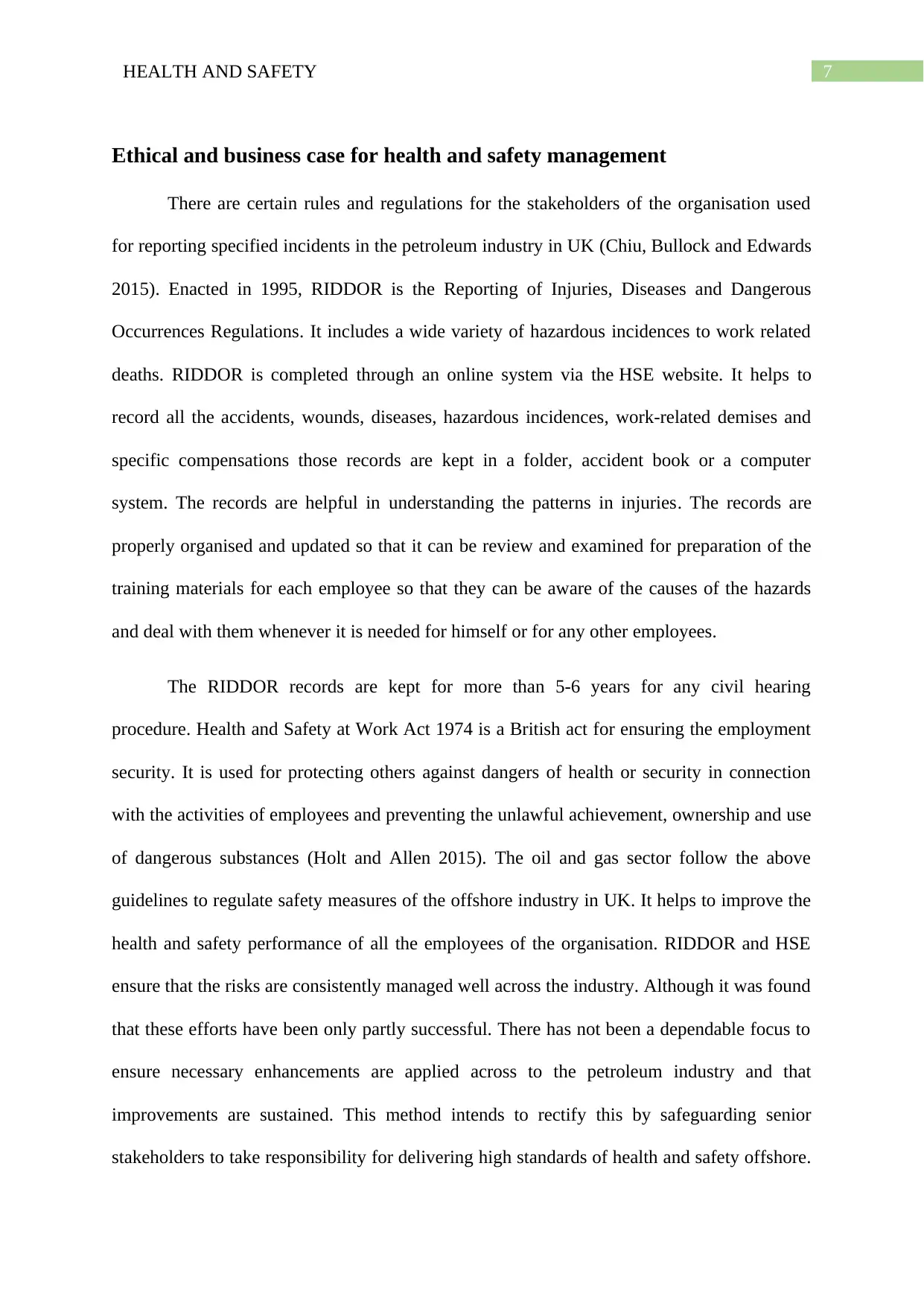
7HEALTH AND SAFETY
Ethical and business case for health and safety management
There are certain rules and regulations for the stakeholders of the organisation used
for reporting specified incidents in the petroleum industry in UK (Chiu, Bullock and Edwards
2015). Enacted in 1995, RIDDOR is the Reporting of Injuries, Diseases and Dangerous
Occurrences Regulations. It includes a wide variety of hazardous incidences to work related
deaths. RIDDOR is completed through an online system via the HSE website. It helps to
record all the accidents, wounds, diseases, hazardous incidences, work-related demises and
specific compensations those records are kept in a folder, accident book or a computer
system. The records are helpful in understanding the patterns in injuries. The records are
properly organised and updated so that it can be review and examined for preparation of the
training materials for each employee so that they can be aware of the causes of the hazards
and deal with them whenever it is needed for himself or for any other employees.
The RIDDOR records are kept for more than 5-6 years for any civil hearing
procedure. Health and Safety at Work Act 1974 is a British act for ensuring the employment
security. It is used for protecting others against dangers of health or security in connection
with the activities of employees and preventing the unlawful achievement, ownership and use
of dangerous substances (Holt and Allen 2015). The oil and gas sector follow the above
guidelines to regulate safety measures of the offshore industry in UK. It helps to improve the
health and safety performance of all the employees of the organisation. RIDDOR and HSE
ensure that the risks are consistently managed well across the industry. Although it was found
that these efforts have been only partly successful. There has not been a dependable focus to
ensure necessary enhancements are applied across to the petroleum industry and that
improvements are sustained. This method intends to rectify this by safeguarding senior
stakeholders to take responsibility for delivering high standards of health and safety offshore.
Ethical and business case for health and safety management
There are certain rules and regulations for the stakeholders of the organisation used
for reporting specified incidents in the petroleum industry in UK (Chiu, Bullock and Edwards
2015). Enacted in 1995, RIDDOR is the Reporting of Injuries, Diseases and Dangerous
Occurrences Regulations. It includes a wide variety of hazardous incidences to work related
deaths. RIDDOR is completed through an online system via the HSE website. It helps to
record all the accidents, wounds, diseases, hazardous incidences, work-related demises and
specific compensations those records are kept in a folder, accident book or a computer
system. The records are helpful in understanding the patterns in injuries. The records are
properly organised and updated so that it can be review and examined for preparation of the
training materials for each employee so that they can be aware of the causes of the hazards
and deal with them whenever it is needed for himself or for any other employees.
The RIDDOR records are kept for more than 5-6 years for any civil hearing
procedure. Health and Safety at Work Act 1974 is a British act for ensuring the employment
security. It is used for protecting others against dangers of health or security in connection
with the activities of employees and preventing the unlawful achievement, ownership and use
of dangerous substances (Holt and Allen 2015). The oil and gas sector follow the above
guidelines to regulate safety measures of the offshore industry in UK. It helps to improve the
health and safety performance of all the employees of the organisation. RIDDOR and HSE
ensure that the risks are consistently managed well across the industry. Although it was found
that these efforts have been only partly successful. There has not been a dependable focus to
ensure necessary enhancements are applied across to the petroleum industry and that
improvements are sustained. This method intends to rectify this by safeguarding senior
stakeholders to take responsibility for delivering high standards of health and safety offshore.

8HEALTH AND SAFETY
Giving the proper knowledge about the various types of health hazards to all the employees
working in the petroleum industry in UK is very important. The employee training is
conducted to improve the worker's abilities and to help the other employee to gain an
essential information and skill to efficiently and lucratively achieve the job without harming
any entity (Grant 2013).
In the petroleum industry, PPE is damaged across the panel but varies site-by-site
according to the chemical threats encountered (Podgorski et al. 2017). The upstream oil
sector includes a variety of worker tasks that may require different levels of protection from
equipment maintenance to oil-based drilling. Hazards vary from low-level dirt and grime to
low concentrations of chemicals in oil-based muds. Sulfuric acid and a variety of
solvents including benzene, xylene and toluene (Kelland 2014). Safe working in the
petroleum industries requires systems in place to administer such hazards for workers and
assets. A strong permit to work system establishes executive work control that is necessary.
The fire-detection and warning system of the oil and gas sector in UK is helpful in warning
people in the structure in all conditions (Malsane et al. 2015). The fire extinguishers are
installed, tested and maintained in accordance with instructions. Ethical issues raised in this
report concerns the sustainability of human rights and the acceptance of social responsibility
of the ptroleum industries during the extraction of petroleum since the oil and gas industries
operate in some difficult locations and adverse weather conditions (Raufflet, Cruz and Bres
2014).
Internationally a corporation named IPIECA ensures that the oil and gas industry are
sustaining good ethics and human rights policies by providing them with tools to respond
effectively to environmental and social issues. The aspects considered with respect to the
permission to work in the offshore petroleum industry such as skills and knowledge which
Giving the proper knowledge about the various types of health hazards to all the employees
working in the petroleum industry in UK is very important. The employee training is
conducted to improve the worker's abilities and to help the other employee to gain an
essential information and skill to efficiently and lucratively achieve the job without harming
any entity (Grant 2013).
In the petroleum industry, PPE is damaged across the panel but varies site-by-site
according to the chemical threats encountered (Podgorski et al. 2017). The upstream oil
sector includes a variety of worker tasks that may require different levels of protection from
equipment maintenance to oil-based drilling. Hazards vary from low-level dirt and grime to
low concentrations of chemicals in oil-based muds. Sulfuric acid and a variety of
solvents including benzene, xylene and toluene (Kelland 2014). Safe working in the
petroleum industries requires systems in place to administer such hazards for workers and
assets. A strong permit to work system establishes executive work control that is necessary.
The fire-detection and warning system of the oil and gas sector in UK is helpful in warning
people in the structure in all conditions (Malsane et al. 2015). The fire extinguishers are
installed, tested and maintained in accordance with instructions. Ethical issues raised in this
report concerns the sustainability of human rights and the acceptance of social responsibility
of the ptroleum industries during the extraction of petroleum since the oil and gas industries
operate in some difficult locations and adverse weather conditions (Raufflet, Cruz and Bres
2014).
Internationally a corporation named IPIECA ensures that the oil and gas industry are
sustaining good ethics and human rights policies by providing them with tools to respond
effectively to environmental and social issues. The aspects considered with respect to the
permission to work in the offshore petroleum industry such as skills and knowledge which
⊘ This is a preview!⊘
Do you want full access?
Subscribe today to unlock all pages.

Trusted by 1+ million students worldwide

9HEALTH AND SAFETY
are used to recognise a threat before and during maintenance. Ability to work in risky
atmospheres and good communication skills. The employees should be sufficiently
knowledgeable, trained and supervised to minimise a human failing during operation of the
work permit system (Selley and Sonnenberg 2014).
Health and safety issues
The effective administration of major threats is an integral feature of safe operations
on offshore the oil and gas sector in UK (Adgate, Goldstein and McKenzie 2014). There are
strong detecting systems to identify and evaluate the chief accident hazards and it specifies
measures taken to safeguard that major accident hazards are measured to ensure obedience
with the relevant provisions. The offshore oil industry in UK constantly putting effort into
making its operations safer as they need to remain competitive in the fiercely contested
energy market (Adgate, Goldstein and McKenzie 2014). A big corporation like them cannot
afford incidents and accidents for the many reasons as their performance is measured in
safety terms as well as other values.
The planned prototype is analysed to improve the approximation of the risk and its
impacts in the offshore oil and gas sector in UK (Castellote and Llorens 2016). The model
involves both quantitative and qualitative methods. The contents of the model involve
Likelihood assessment where the estimation of the probability of the failures is reviewed to
build generic conception considering the facilities in the industry. The qualitative assessment
is the probabilistic future abilities it includes the Fault Tree Analysis (FTA) which have
components of the failure data and human reliability which are helpful in determining the
frequency of the occurrences of the incidents. Quantitative assessment is conducted for
are used to recognise a threat before and during maintenance. Ability to work in risky
atmospheres and good communication skills. The employees should be sufficiently
knowledgeable, trained and supervised to minimise a human failing during operation of the
work permit system (Selley and Sonnenberg 2014).
Health and safety issues
The effective administration of major threats is an integral feature of safe operations
on offshore the oil and gas sector in UK (Adgate, Goldstein and McKenzie 2014). There are
strong detecting systems to identify and evaluate the chief accident hazards and it specifies
measures taken to safeguard that major accident hazards are measured to ensure obedience
with the relevant provisions. The offshore oil industry in UK constantly putting effort into
making its operations safer as they need to remain competitive in the fiercely contested
energy market (Adgate, Goldstein and McKenzie 2014). A big corporation like them cannot
afford incidents and accidents for the many reasons as their performance is measured in
safety terms as well as other values.
The planned prototype is analysed to improve the approximation of the risk and its
impacts in the offshore oil and gas sector in UK (Castellote and Llorens 2016). The model
involves both quantitative and qualitative methods. The contents of the model involve
Likelihood assessment where the estimation of the probability of the failures is reviewed to
build generic conception considering the facilities in the industry. The qualitative assessment
is the probabilistic future abilities it includes the Fault Tree Analysis (FTA) which have
components of the failure data and human reliability which are helpful in determining the
frequency of the occurrences of the incidents. Quantitative assessment is conducted for
Paraphrase This Document
Need a fresh take? Get an instant paraphrase of this document with our AI Paraphraser
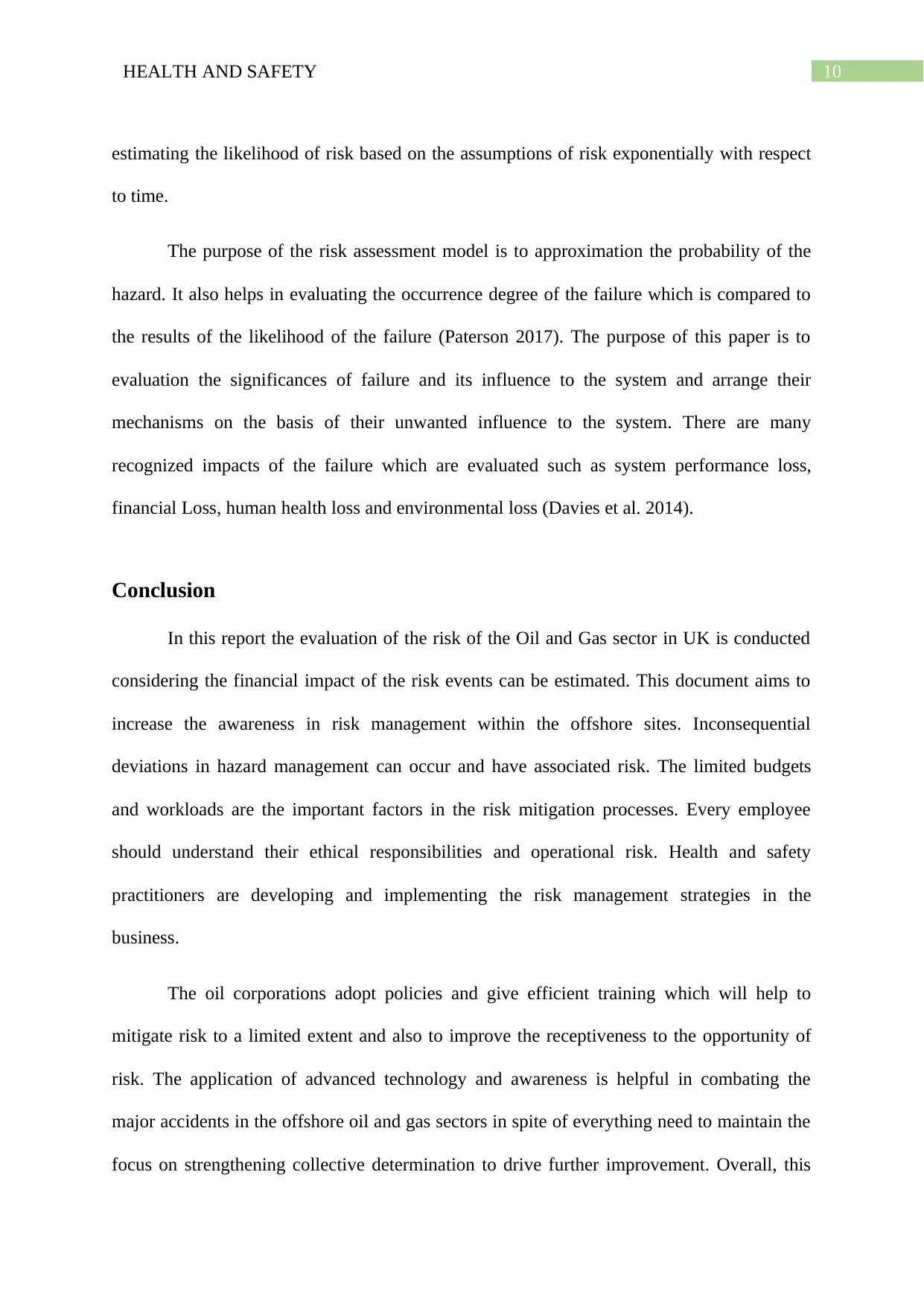
10HEALTH AND SAFETY
estimating the likelihood of risk based on the assumptions of risk exponentially with respect
to time.
The purpose of the risk assessment model is to approximation the probability of the
hazard. It also helps in evaluating the occurrence degree of the failure which is compared to
the results of the likelihood of the failure (Paterson 2017). The purpose of this paper is to
evaluation the significances of failure and its influence to the system and arrange their
mechanisms on the basis of their unwanted influence to the system. There are many
recognized impacts of the failure which are evaluated such as system performance loss,
financial Loss, human health loss and environmental loss (Davies et al. 2014).
Conclusion
In this report the evaluation of the risk of the Oil and Gas sector in UK is conducted
considering the financial impact of the risk events can be estimated. This document aims to
increase the awareness in risk management within the offshore sites. Inconsequential
deviations in hazard management can occur and have associated risk. The limited budgets
and workloads are the important factors in the risk mitigation processes. Every employee
should understand their ethical responsibilities and operational risk. Health and safety
practitioners are developing and implementing the risk management strategies in the
business.
The oil corporations adopt policies and give efficient training which will help to
mitigate risk to a limited extent and also to improve the receptiveness to the opportunity of
risk. The application of advanced technology and awareness is helpful in combating the
major accidents in the offshore oil and gas sectors in spite of everything need to maintain the
focus on strengthening collective determination to drive further improvement. Overall, this
estimating the likelihood of risk based on the assumptions of risk exponentially with respect
to time.
The purpose of the risk assessment model is to approximation the probability of the
hazard. It also helps in evaluating the occurrence degree of the failure which is compared to
the results of the likelihood of the failure (Paterson 2017). The purpose of this paper is to
evaluation the significances of failure and its influence to the system and arrange their
mechanisms on the basis of their unwanted influence to the system. There are many
recognized impacts of the failure which are evaluated such as system performance loss,
financial Loss, human health loss and environmental loss (Davies et al. 2014).
Conclusion
In this report the evaluation of the risk of the Oil and Gas sector in UK is conducted
considering the financial impact of the risk events can be estimated. This document aims to
increase the awareness in risk management within the offshore sites. Inconsequential
deviations in hazard management can occur and have associated risk. The limited budgets
and workloads are the important factors in the risk mitigation processes. Every employee
should understand their ethical responsibilities and operational risk. Health and safety
practitioners are developing and implementing the risk management strategies in the
business.
The oil corporations adopt policies and give efficient training which will help to
mitigate risk to a limited extent and also to improve the receptiveness to the opportunity of
risk. The application of advanced technology and awareness is helpful in combating the
major accidents in the offshore oil and gas sectors in spite of everything need to maintain the
focus on strengthening collective determination to drive further improvement. Overall, this

11HEALTH AND SAFETY
paper is helpful in enhancing the effectiveness of the maintenance by assessing risk which is
authoritative is the nature of the oil and gas sector. Based on the descriptive evaluation of the
risk management strategies it can be taken under consideration that one of the prime
challenges that arise when comparing safety data in the petroleum industry of UK is the fact
that they have a variety of regimes, contexts and histories of regulation. Incident and accident
information is often taken as the single defining measure of the industry s safety and health
status.
The Oil corporations have robust detecting systems for evaluation of the chief
accidental hazards and preservation of those major accidents. The offshore oil industry in UK
emphasizes on their operations as they need to remain competitive in the market. This paper
also describes a proposed model involving both quantitative and qualitative methods is
analysed to boost the approximation of the hazard and its significances. Oil and gas sector in
UK have well drilling and servicing activities involving different types of equipment and
materials. Identifying and controlling threats is critical to preventing damages and deaths.
paper is helpful in enhancing the effectiveness of the maintenance by assessing risk which is
authoritative is the nature of the oil and gas sector. Based on the descriptive evaluation of the
risk management strategies it can be taken under consideration that one of the prime
challenges that arise when comparing safety data in the petroleum industry of UK is the fact
that they have a variety of regimes, contexts and histories of regulation. Incident and accident
information is often taken as the single defining measure of the industry s safety and health
status.
The Oil corporations have robust detecting systems for evaluation of the chief
accidental hazards and preservation of those major accidents. The offshore oil industry in UK
emphasizes on their operations as they need to remain competitive in the market. This paper
also describes a proposed model involving both quantitative and qualitative methods is
analysed to boost the approximation of the hazard and its significances. Oil and gas sector in
UK have well drilling and servicing activities involving different types of equipment and
materials. Identifying and controlling threats is critical to preventing damages and deaths.
⊘ This is a preview!⊘
Do you want full access?
Subscribe today to unlock all pages.

Trusted by 1+ million students worldwide
1 out of 16
Related Documents
Your All-in-One AI-Powered Toolkit for Academic Success.
+13062052269
info@desklib.com
Available 24*7 on WhatsApp / Email
![[object Object]](/_next/static/media/star-bottom.7253800d.svg)
Unlock your academic potential
Copyright © 2020–2025 A2Z Services. All Rights Reserved. Developed and managed by ZUCOL.





